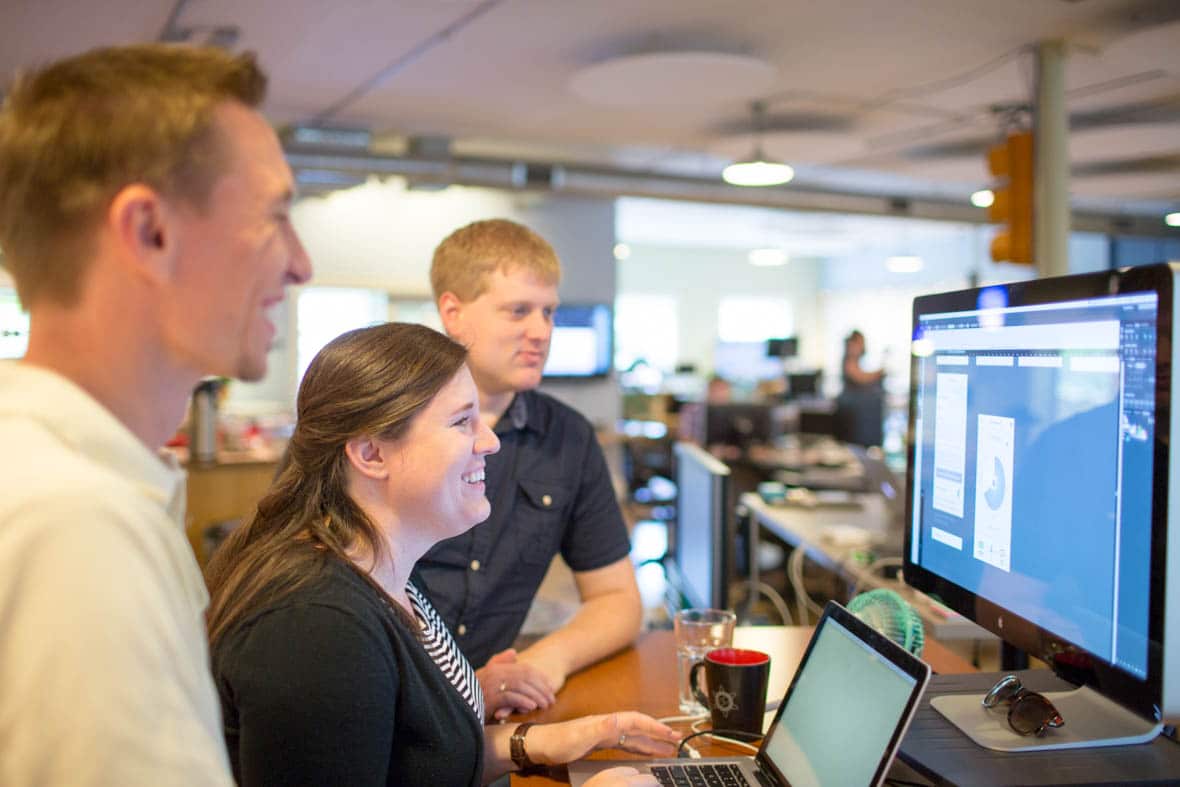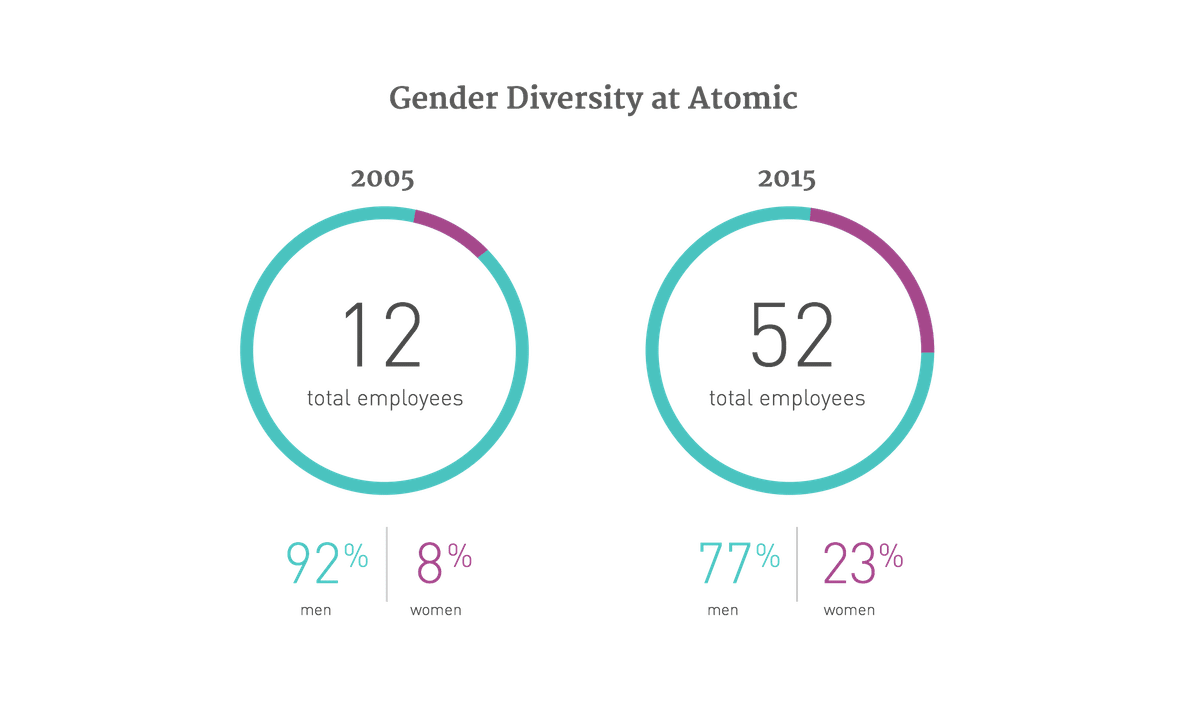We’ve been working for several years to improve the gender balance at Atomic Object, largely because we held “Diversity is good” to be self-evident. But recently I decided it was important to think through this belief and better understand it. Here’s why I think diversity is valuable, and makes my company stronger.
Diversity Means Liberty
Rather than an unquestioned end unto itself, I find it useful to think about diversity as an indicator of something valuable. Diversity in a profession is a measure of society’s success in achieving liberty. It indicates opportunity that can be capitalized on by anyone, regardless of gender, race, country of origin, age, etc.
Presuming there is no profession that is uninteresting to or unachievable by any particular group of people, then a diverse workforce is an indicator that there are no artificial barriers in place in the profession. The “natural” diversity of any given profession, absent of obstacles, is debatable. I believe all professions are attainable and of at least some interest to all groups of people. Increased liberty creates flexibility, greater productivity, and less waste from untapped talent. I think about this as labor market optimization.
In a liberal (in the British sense) society we place a value on an individual’s ability to make their own choices. This concept is famously noted in our Declaration of Independence as “Life, Liberty and the pursuit of Happiness”. Given how much of our lives we spend working, it’s hard to imagine achieving this goal with artificial constraints on career choice. A profession with very little diversity is a likely indicator of limits on liberty.
A simple thought experiment illustrates my point. If there were no men working as nurses, and no women working in construction, then I think we could definitely say there are barriers that are constraining liberty, and thus sub-optimizing labor market productivity and personal fulfillment. On the other hand, if men hold some but not as many as half of the nursing jobs, it’s much harder to make confident statements about that situation as regards opportunity, barriers, economic optimization, or people’s happiness.
In my view, the societal benefit isn’t diversity per se, but what the presence of diversity indicates. It’s a measure of something very good (liberty), not a goal unto itself.
My Selfish Interest in Diversity
When I think of diversity within my company, I take a less abstract, more selfish view. I value a diverse workforce because it makes my company stronger, more interesting, more likely to succeed in the short-term, and more likely to survive for the long-term.
From what I’ve seen and read, diversity of employees creates greater diversity in these important attributes:
- perspective
- insight
- style of communication and human interaction
- skills
- breadth of knowledge
- approach to problem solving
- working style
- life experience
And in turn, I believe that diversity in the attributes above results in the following valuable outcomes for the company.
Greater team intelligence
A researcher at the University of Michigan finds diversity improves the collective intelligence of a team. MIT researchers found that collective intelligence was linked to cooperation, and that effective cooperation was linked to the number of women in a group.
Better decision making, more innovation
Studies suggest that some women and men differ dramatically when making decisions under stress; women improve their decision making while men worsen theirs. Creativity is improved through diversity of ideas and debate.
Better project results
Having gender-diversified teams means a greater range of end-user empathy. That helps us create more effective products. A more diverse team also tends to increase the domain knowledge available to the team.
Broader base of clients
Some clients care very directly about diversity, per se. They value and expect it in their partners. I’m guessing nearly everyone is more likely to buy from a vendor with whom they can easily identify.
Robustness and resilience
When you can’t predict which challenges the market will throw at you, it’s safer to have a diverse group of people to respond to them. Diversity increases our likelihood of an effective response to a problem or opportunity. Diversity of personality is a strength. I see strong analogies to cities and natural ecosystems. Both are made strong and resilient through their diversity. Monoculture increases risk of failure.
Wider talent pool
Talent scarcity has been and looks to remain a key force in our industry. Anything that limits us from recruiting a certain group of people makes that problem worse. Having gender diversity in our company makes it easier to recruit from the small but growing pool of women developers and designers; not everyone would be comfortable working at a place where they are the only, or one of very few, women.
Greater range of leadership style
A greater range of leadership style increases the robustness of the company, as different situations, people and positions require different approaches. It’s speculated that the correlation between women on corporate boards and above average financial returns is attributable to different leadership styles and decision making.
Financial results
Companies with greater gender diversity do better financially. A study by a researcher at the University of Illinois at Chicago found gender diversity was correlated with increased sales and more customers. McKinsey found gender and racial diversity correlated with above-average financial returns.
More interesting workplace
In addition to the positive outcomes above, my personal belief is that diversity makes our company a more interesting place to work. I really enjoy the variety of hobbies, conversation, experiences, dress, styles, and knowledge that company diversity creates. It’s also a positive feedback loop, as interesting people attract more interesting people. In times of talent scarcity, this should be a competitive advantage.
“Diversity and independence are important because the best collective decisions are the product of disagreement and contest, not consensus or compromise.”
At What Cost?
We cultivate diversity to make the company better, not to make our lives easier. Differences mean more debate and explaining. Solutions can take longer to agree on. Diversity demands better listening skills. But this work also builds muscles we need to be successful consultants and innovators.
Alignment on priorities simplifies achieving alignment within a company. With diversity comes a broader range of priorities, priorities which may conflict. Conflicting priorities result in debate, questioning, negotiation, and compromise. That takes time and isn’t always easy. Diversity therefore increases friction within a company. On the other hand, I believe the introspection and open debate on priorities is valuable, and can avoid the trap of assumed alignment.
Diversity is about better, not easier.
Atomic’s Current Priority & Focus
There are many dimensions of human diversity that result in a greater range of desirable attributes. At the very least, diversity in skills and styles may come from diversity in age, gender, race, sexual orientation, physical ability, national origin, career experience, religion, education, and family background. And I’m no doubt missing some other legitimate dimensions.
From society’s perspective, all of these dimensions of diversity are useful and equally valuable measures of achieving greater liberty and therefore economic and individual benefits. Whether a profession is closed to people of a certain race, or people of a certain gender, or a certain religion, doesn’t matter. All of those situations are equally wrong; liberty will have been curtailed, and our society will be made poorer.
From a narrow company perspective, I think focusing first on a single dimension of diversity is most effective. The dimension of diversity we focus on in our company is gender.
What We’re Doing
The low participation rate of women in software development indicates a curtailment of liberty, in my opinion. We support groups, with money, space, time, and expertise, working to increase the participation of women in computer science, programming and software design. Most of our efforts are contributions to the societal problem, i.e. we don’t expect a direct return on our investment when it comes to our company’s gender balance. On that front, we actively recruit women software developers and designers. We make extra efforts to encourage them to apply, we make sure we fully investigate their abilities and experience, going beyond the resume if necessary, and I personally invest time in the recruiting and vetting process for women candidates. Our hiring standards are identical. We craft creative plans for women who are returning to the field after focusing on raising children. We support part-time employment for people who want to both work and raise children. We’ve been doing these things for years.
Inspired by some new voices in the company, in 2015 we reviewed our benefits and policies and made some changes we hope make us an even more attractive place for women to work. These changes include more generous parental leave, modifying our operating agreement to allow for part-time employee shareholders, reviewing and modifying the language in our hiring artifacts, changing how people get raises, and formally recognizing Mary O’Neill’s long-standing, de-facto leadership role in the company.
We focus our efforts on designers and developers because that’s who we mostly employ. Also, improving project success through greater diversity benefits our clients. We track and measure our success broadly, however, because many of the benefits we gain from greater gender diversity aren’t limited to maker roles. For the purposes of tracking our progress, we simplify the world into the gender binary of “men” and “women”. I realize this simplification isn’t an accurate model of the real world, and while I don’t like the disenfranchisement it represents, I think it’s a pragmatic approach to the business problem we’re working on and want to measure.
Why Gender Diversity First
We choose to work on increasing our gender diversity because I believe it’s the dimension of diversity that we stand to benefit from the most. Gender is based on biology and culture. These are powerful forces that create significant differences between people in ways that make a difference to our business. It’s also a dimension that splits the world more or less in halves. While I agree that the many other dimensions of diversity have an influence on people that can contribute to our company, I think gender diversity gives us the most benefit today.
For the many dimensions of diversity that we don’t actively focus on, it’s important to note that we are welcoming and non-discriminating. We’ll happily hire anyone who can help us achieve our mission. When we have an opportunity, we sometimes support programs that are aimed at other dimensions of diversity. But they aren’t our focus right now.
Becoming a more gender-balanced company is difficult when the most common job in our company is software developer, and women comprise less than 20% of computer science graduates. I’m hoping that our focus and special efforts will get us to a point where we have a good, self-maintaining gender balance. I see signs that this is happening. If we reach that goal, we won’t need to focus on this particular issue forever.
Though we’ve come a long way in 10 years, as the chart above shows, we’re not satisfied with the status quo. We continue to contribute to solving the societal problem of a gender imbalance in software, as well as working to improve our own gender diversity, especially within software development and design.
- Attention: Spending Your Most Valuable Currency - February 10, 2022
- Slicing the Revenue Pie in a Multi-Stakeholder Company - July 30, 2021
- Commercial versus Existential Purpose - July 19, 2021
- How I Misunderstood Mentorship and Benefited Anyway - June 16, 2021
- Sabbath Sundays and Slow Mondays - June 4, 2021

